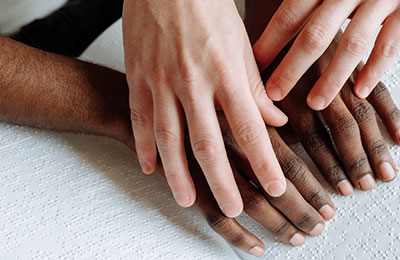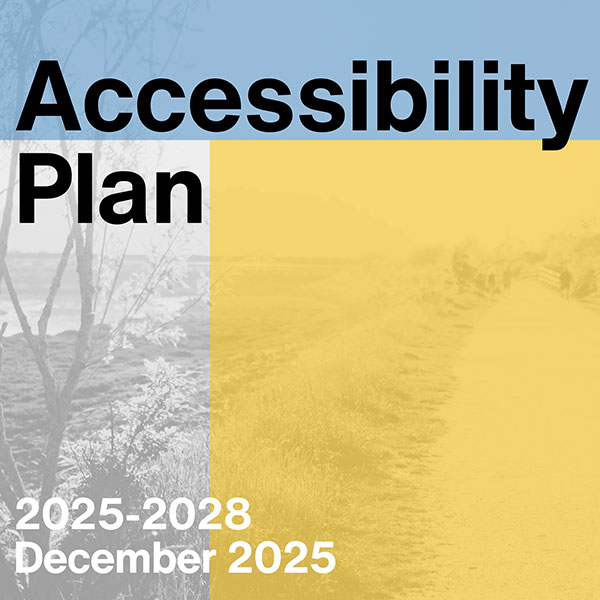Introduction
SK Arts values an equitable, diverse and inclusive world, where all people have fair access to the tools and resources needed to realize creative and community endeavors.
We recognize the importance of accessibility for all people and are committed to identifying and removing barriers for the people we serve. Our accessibility plan outlines the steps we will take over the next three years to improve accessibility and opportunities for persons with disabilities.
Our Accessibility Plan will continue to evolve through dialogue and collaboration with the disability community, employees and stakeholders to ensure it remains responsive and effective.

Engagement
In developing this plan, we:
- Formed an accessibility committee to identify known and potential barriers, and possible solutions.
- Held discussions with staff and stakeholders in the arts community.
- Conducted an organizational Disability Audit with Listen to Dis', an arts organization that serves artists with disabilities.
- Coordinated future staff training and audits of our physical space and website with CNIB and Learning Disabilities of Saskatchewan.
We commit to ongoing engagement with persons with disabilities in implementing and reviewing this plan.
Accessibility Achievements

Physical Accessibility
- All organizational locations feature wheelchair-accessible entrances that meet current accessibility standards.
- Artwork labels within our collection have been redesigned with larger font sizes and higher-contrast text to improve legibility for visitors with visual impairments.
- All event venues used by the organization comply with physical accessibility standards, and additional accommodations are available to attendees upon request.
- Ergonomic equipment, including sit-stand desk converters and noise- cancelling headphones, has been made available to staff to support accessibility and wellness in the workplace.
Digital Content and Website Accessibility
- All video content produced by the organization includes closed captioning to ensure full accessibility for individuals who are Deaf or hard of hearing.
- Closed captioning is also provided for all Zoom meetings and online presentations.
- The organization’s website meets the Web Content Accessibility Guidelines (WCAG) 2.1 Level AA standards.
- Multiple accessibility supports are offered through our Accessibility Fund to assist artists in completing online grant applications, including alternate submission options.
- Alternative text (alt text) is consistently applied to images on the website and across social media platforms to enhance accessibility for screen reader users.

Organizational Culture
- The organization continues to strengthen its culture of accessibility through ongoing awareness, training and leadership commitment to meaningful inclusion.
- A Current State of Diversity, Equity and Inclusion (DEI) Assessment was completed in partnership with Canadian Equity Consulting. The leadership team is actively implementing recommendations from this report to embed accessibility and equity across all levels of the organization.
Policies and Programs
- Grant review panel scoring frameworks now include equity considerations, assigning additional points to artists and organizations from underserved or priority groups.
- The organization’s hybrid work policy provides flexibility for employees to work remotely, supporting accessibility and work-life balance.
Goals and Actions
Goal 1: Continue Consultations with Impacted People and Groups
Objective: Strengthen collaboration and ensure that accessibility initiatives are guided by the lived experiences of people with disabilities.
| Actions | Deadline |
|---|---|
| Continue regular consultations with local and regional disability organizations to inform ongoing accessibility improvements. | Ongoing |
| Review this Accessibility Plan annually in collaboration with staff, stakeholders and partner organizations, incorporating feedback and updates as needed. | Annually |
Goal 2: Improve Employee and Grant Panelist Awareness of Accessibility
Objective: Build organizational awareness and capacity to support accessibility and inclusion across all programs and operations.
| Actions | Deadline |
|---|---|
| Deliver Inclusion and Accessibility Training for all staff. | Spring 2026 |
| Integrate accessibility awareness and training into the onboarding process for all new employees. | Winter 2025 |
| Provide training for grant assessment panelists. | Fall 2026 |
Goal 3: Make Office and Other Facilities More Accessible
Objective: Remove physical and environmental barriers to ensure that all facilities are welcoming and accessible to staff and visitors.
| Actions | Deadline |
|---|---|
| Conduct a comprehensive physical space accessibility audit in partnership with CNIB. | Spring 2026 |
| Ensure all washrooms in office and program spaces are fully accessible. | Fall 2028 |
| Install automatic power-assist doors at main entrances and implement consistent, high-contrast directional signage. | Fall 2028 |
| Develop and implement an accessibility checklist to ensure all event venues meet accessibility standards. | Spring 2026 |
| Incorporate additional recommendations arising from CNIB’s audit into facility planning and improvements. | 2026-2028 |
Goal 4: Enhance Accessibility of Programs and Services
Objective: Ensure that all programs, grants, and events are accessible and inclusive for participants with disabilities.
| Actions | Deadline |
|---|---|
| Review and simplify grant application guidelines to ensure they are accessible and easy to understand. | Winter 2028 |
| Ensure that scoring rubrics for all grant programs include criteria that recognize priority and equity-seeking groups. | Winter 2027 |
| Integrate accessibility requirements into the Permanent Collection Guidelines and acquisition procedures. | Winter 2027 |
| Create accessible and user-friendly registration procedures for events, webinars and public programs. | Spring 2028 |
Goal 5: Improve Digital Accessibility
Objective: Ensure that digital platforms meet or exceed accessibility standards and are usable by all audiences
| Actions | Deadline |
|---|---|
| Conduct a full website accessibility audit with CNIB, including both a lived-user experience audit and a technical audit by accessibility specialists. | Spring 2026 |
| Distribute a website accessibility survey to staff, stakeholders and disability organizations to gather feedback. | Winter 2025 |
| Implement CNIB’s recommendations and make the required technical and content updates to the website. | Fall 2026 |
Goal 6: Incorporate Accessibility Requirements into Internal Policies and Procedures
Objective: Embed accessibility and inclusion principles into all internal policies, processes and governance frameworks.
| Actions | Deadline |
|---|---|
| Review and update hiring, accommodation and recruitment policies to strengthen accessibility and equity provisions. | Spring 2027 |
| Develop a Diverse Workforce Letter of Agreement (LOA) in collaboration with SGEU. | Spring 2026 |
| Re-establish the Equity Working Circle and the Accessibility Working Group to guide implementation and review of accessibility initiatives. | Spring 2026 |
Monitoring, Reporting and Review
Progress on this plan will be reviewed quarterly by the Accessibility Working Group and reported annually to senior leadership. A summary of progress and completed actions will be shared publicly on our website. The plan will be reviewed and updated every three years or as required by The Accessible Saskatchewan Act.
Conclusion
SK Arts supports the values of inclusion and accessibility. We are committed to improving accessibility and promoting the full and equal participation of persons with disabilities.

Feedback
We value your feedback and welcome members of the public to submit comments about our accessibility plan using the contact information below.
Chancz Perry
Program Consultant
Phone: (306) 550-1707
Email:
Address: 1355 Broad Street, Regina, SK, S4R 7V1

